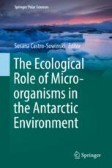Search
Search Results
-
Persistent organic pollutants and mercury in a colony of Antarctic seabirds: higher concentrations in 1998, 2001, and 2003 compared to 2014 to 2016
Over decades, persistent organic pollutants (POPs) and trace metals like mercury (Hg) have reached the remotest areas of the world such as Antarctica...

-
Avian Locomotion: Flying, Running, Walking, Climbing, Swimming, and Diving
Most birds can fly, but can also, to varying degrees depending on the species and their habitats, walk, run, climb, swim, and dive. With a focus on...
-
Endocrine System
The avian endocrine system includes the hypothalamus, pituitary gland, thyroid gland, ultimobranchial glands, adrenal glands, endocrine cells in the...
-
Landscape genomics: natural selection drives the evolution of mitogenome in penguins
BackgroundMitochondria play a key role in the balance of energy and heat production, and therefore the mitochondrial genome is under natural...

-
Exploration during early life: distribution, habitat and orientation preferences in juvenile king penguins
BackgroundThe early life of marine apex predators is poorly known, particularly for diving species. The orientation and foraging skills are...

-
A Morphological Review of the Enigmatic Elongated Tail Feathers of Stem Birds
Several stem birds, such as Confuciusornithidae and Enantiornithes, were characterized by the possession of one or two pairs of conspicuous,...
-
Ontogenetic variations of the head of Aptenodytes forsteri (Aves, Sphenisciformes): muscular and skull morphology
The emperor penguin ( Aptenodytes forsteri) is the largest extant penguin among living species breeding in winter, at Antarctic high latitudes....

-
Weddell seal (Leptonychotes weddellii) killing Gentoo Penguin (Pygoscelis papua) at Neko Harbour, Antarctic Peninsula
Weddell seals ( Leptonychotes weddellii ) typically prey on fish, cephalopods, and invertebrates. While other seal species also include penguins as...

-
Codex Sinaiticus
At least, for all of its paradoxical truancies, the search for paradise in Sinai mirrors human evolution: gaps and discrepancies in translation,...
-
Immunolocalization and phylogenetic profiling of the feather protein with the highest cysteine content
Feathers are the most complex skin appendages of vertebrates. Mature feathers consist of interconnected dead keratinocytes that are filled with...

-
Genomic insights into natural selection in the common loon (Gavia immer): evidence for aquatic adaptation
BackgroundThe common loon ( Gavia immer ) is one of five species that comprise the avian order Gaviiformes. Loons are specialized divers, reaching...

-
Molecular Biology of RNA Viruses Isolated in Antarctica
RNA viruses exist as collections of closely related viral genomes, termed quasispecies, subjected to a continuous process of genetic variation,...
-
Habitat preferences of Adélie Pygoscelis adeliae and Chinstrap Penguins Pygoscelis antarctica during pre-moult in the Weddell Sea (Southern Ocean)
In order to understand and mitigate for the potential impacts of anthropogenic disturbance on marine predators, it is fundamental to gain insight...

-
Regulation of Flowering in Orchids
Orchids constitute the largest families within the flowering plants; they are one of the most highly evolved groups in the angiosperms; and because...
-
An overview of behavioral, physiological, and environmental sensors used in animal biotelemetry and biologging studies
BackgroundThe ability to remotely monitor the behavior of animals and their interactions with their environment has revolutionized how ecologists...

-
Blood chemistry values in nestlings of Rockhopper Penguins (Eudyptes chrysocome): the effect of sex and body condition
Hematological studies concerned with the determination of normal values of blood parameters in animals have been increasing. However, studies on...

-
South Polar Skua breeding populations in the Ross Sea assessed from demonstrated relationship with Adélie Penguin numbers
In the Ross Sea region, most South Polar Skuas ( Stercorarius maccormicki ) nest near Adélie Penguin ( Pygoscelis adeliae ) colonies, preying and...

-
Fascinating Natural and Biological Traits of Birds
The natural history of birds is summarized. Account of what contemporary birds are, when and how they came to be what they are, and why and how they...
-
Molecular mechanisms of adaptive evolution in wild animals and plants
Wild animals and plants have developed a variety of adaptive traits driven by adaptive evolution, an important strategy for species survival and...
-
A new fossil from the mid-Paleocene of New Zealand reveals an unexpected diversity of world’s oldest penguins
We describe leg bones of a giant penguin from the mid-Paleocene Waipara Greensand of New Zealand. The specimens were found at the type locality of Waim...

